/UCI%20Ecological%20Preserve,%20Irvine,%20CA.%206-27-11%20025.jpg) UCI Ecological Preserve, Irvine, Orange County, CA. 6-27-11. © Joan Avise. |
California Buckwheat Eriogonum fasciculatum, spp. fasciculatum A low, spreading generally decumbent perennial shrub with 2-4 ft. branches. There are four similar subspecies recognized. This subpecies (fasciculatum) is tetraploid (n=40). Polygonaceae; Subfamily Eriogonoideae Back to Polygonaceae of Orange County, California |
||
/UCI%20Ecological%20Preserve,%20Irvine,%20CA.%206-27-11%20023.jpg) UCI Ecological Preserve, Irvine, Orange County, CA. 6-27-11. © Joan Avise. |
/UCI%20Ecological%20Preserve,%20Irvine,%20CA.%206-27-11%20026.jpg) UCI Ecological Preserve, Irvine, Orange County, CA. 6-27-11. © Joan Avise. |
||
/decumbent%20growth%20form%20Crystal%20Cove%20State%20Beach,%20Laguna%20Beach,%20CA.%20%203-21-09%20150.jpg) Decumbent growth form. Crystal Cove State Park, Laguna Beach, Orange County, CA. 3-21-09. © Joan Avise. |
 Flower clusters form at the ends of 1-4 in. leafless stems in heads about 1 inch in diameter. © Peter J. Bryant |
||
/leaves%20green,%20smooth%20(glabrous)%20above%20UCI%20Ecological%20Preserve,%20Irvine,%20CA.%20%2012-02-11%20005.jpg) The leaves grow in bundles (fascicled), smooth (glabrous) and green above. UCI Ecological Preserve, Irvine, Orange County, CA. 12-02-11. © Joan Avise. |
/leaf%20margins%20tightly%20rolled%20under;%20leaf%20underside%20white%20woolly%20UCI%20Ecological%20Preserve,%20Irvine,%20CA.%20%2012-02-11%20010.jpg) Leaf margins tightly rolled under; leaf underside white and woolly. UCI Ecological Preserve, Irvine, Orange County, CA. 12-02-11. © Joan Avise. |
||
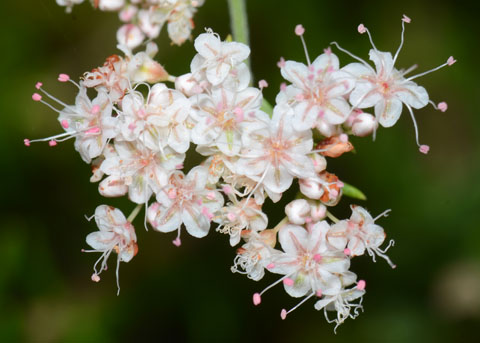 Flowers are only a few mm across but form dense clusters. Moro Canyon, Crystal Cove State Park, Orange County, CA. 11-16-11. © Peter J. Bryant |
/2012-12-16-11b.jpg) Anthers deep pink. Laguna Beach, Orange County, CA. 12-16-12. © Peter J. Bryant (focus-stacked image) |
||
 The 6-lobed calyx is white or pinkish with no petals. Moro Canyon, Crystal Cove State Park, Orange County, CA. 11-16-11. © Peter J. Bryant |
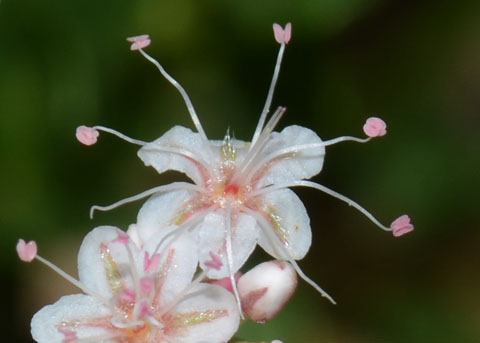 Nine stamens, filaments exserted, spreading, ~3 mm long. Anthers longitudinally dehiscent. Three styles, exserted. Moro Canyon, Crystal Cove State Park, Orange County, CA. 11-16-11. © Peter J. Bryant |
||
/senescent%20chestnet%20flower%20heads%20UCI%20Ecological%20Preserve,%20Irvine,%20CA.%2012-02-11%20046.jpg) Senescent chestnet-colored flower heads. UCI Ecological Preserve, Irvine, Orange County, CA. 12-02-11. © Joan Avise. |
/new%20flowers%20appear%20until%20late%20autumn%20from%20the%20dying%20chestnut%20brown%20heads%20UCI%20Ecological%20Preserve,%20Irvine,%20CA.12-02-11%20060.jpg) New flowers appear until late autumn from the dying chestnut-brown heads. UCI Ecological Preserve, Irvine, Orange County, CA.12-02-11. © Joan Avise. |
||
| Associated Insects | |||
| Buckwheat is a nectar source for numerous butterflies, bees and other insects. It is also the larval foodplant for the following butterflies: | |||
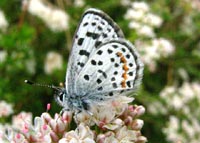 Bernardino Blue, Euphilotes bernardino |
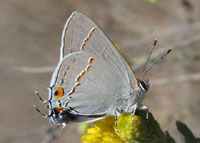 Gray Hairstreak, Strymon melinus |
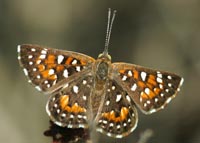 Behr's Metalmark, Apodemia virgulti |
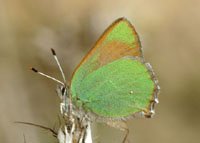 Bramble Hairstreak, Callophrys perplexa |